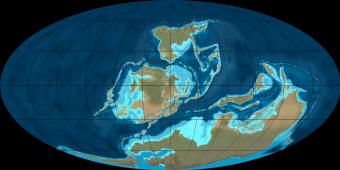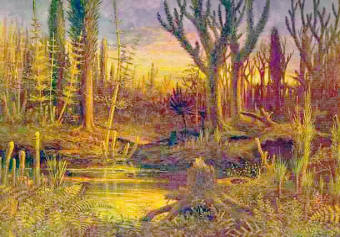History
The period is named after Devon, a county in southwestern England, where Devonian outcrops are common. While the rock beds that define the start and end of the period are well identified, the exact dates are uncertain. The Devonian extends from the end of the Silurian Period 416.0 ± 2.8 Ma, to the beginning of the Carboniferous Period 359.2 ± 2.5 Ma (in North America, the beginning of the Mississippian subperiod of the Carboniferous) (ICS 2004). In nineteenth-century texts the Devonian has been called the "Old Red Age", after the red and brown terrestrial deposits known in the United Kingdom as the Old Red Sandstone in which early fossil discoveries were found. The Devonian has also erroneously been characterized as a "greenhouse age", due to sampling bias: most of the early Devonian-age discoveries came from the strata of western Europe and eastern North America, which at the time straddled the Equator as part of the supercontinent of Euramerica where fossil signatures of widespread reefs indicate tropical climates that were warm and moderately humid but in fact the climate in the Devonian differed greatly between epochs and geographic regions. For example, during the Early Devonian, arid conditions were prevalent through much of the world including Siberia, Australia, North America, and China, but Africa and South America had a warm temperate climate. In the Late Devonian, by contrast, arid conditions were less prevalent across the world and temperate climates were more common.
Subdivisions
The Devonian
Period is formally broken into Early, Middle, and Late subdivisions. The
rocks corresponding to these
epochs are referred to
as belonging to the Lower, Middle, and Upper parts of the Devonian System.
The Early Devonian lasts from 416 ± 2.8 million years
ago to 397.5 ± 2.7 million
years ago and begins with the Lockhovian stage, which lasts until the
Pragian. This spans from 411.2 million years
ago million years ago to 407 ± 2.8 million years
ago, and is followed by the Emsian, which lasts until the Middle Devonian
begins, 397.5± 2.7 million
years ago. The middle Devonian comprises two subdivisions, the Eifelian
giving way to the Givetian 391.8
± 2.7 million
years ago. During this time the armoured jawless
ostracoderm fish were declining in
diversity; the jawed fish were thriving and increasing in diversity in both
the oceans and freshwater. The shallow, warm, oxygen-depleted waters of
Devonian inland lakes, surrounded by primitive plants, provided the
environment necessary for certain early fish to develop essential
characteristics such as well developed lungs, and the ability to crawl out
of the water and onto the land for short periods of time.
Finally, the late Devonian starts with the
Frasnian, 385.3 ± 2.6 million
years ago to 374.5 ± 2.6 million
years ago, during which the first forests were taking shape on land. The
first tetrapods appear in the fossil record in the ensuing Famennian
subdivision, the beginning and end of which are marked with extinction
events. This lasted until the end of the Devonian, 359.2 ± 2.5 million
years ago.
Climate
The Devonian was a relatively warm period, and probably lacked any glaciers. Reconstruction of tropical sea surface temperature from conodont apatite implies an average value of 30 °C (86 °F) in the Early Devonian. CO2 levels dropped steeply throughout the Devonian period as the burial of the newly-evolved forests drew carbon out of the atmosphere into sediments; this may be reflected by a Mid-Devonian cooling of around 5 °C (9 °F). The Late Devonian warmed to levels equivalent to the Early Devonian; while there is no corresponding increase in CO2 concentrations, continental weathering increases (as predicted by warmer temperatures); further, a range of evidence, such as plant distribution, points to Late Devonian warming. The climate would have affected the dominant organisms in reefs; microbes would have been the main reef-forming organisms in warm periods, with corals and stromatoporoid sponges taking the dominant role in cooler times. The warming at the end of the Devonian may even have contributed to the extinction of the stromatoporoids.
Paleogeography
 |
| Paleogeography of the Late Devonian, about 370 Ma (Picture Source) |
The Devonian period was a time of
great tectonic activity, as
Laurasia and
Gondwanaland drew closer together.
The continent
Euramerica (or
Laurussia) was created in the early Devonian by the collision of
Laurentia and
Baltica,
which rotated into the natural dry zone along the
Tropic of Capricorn,
which is formed as much in Paleozoic times as nowadays by the convergence of
two great air-masses, the
Hadley cell and the
Ferrel cell. In these near-deserts, the
Old Red Sandstone
sedimentary beds formed, made red by the oxidized iron (hematite)
characteristic of drought conditions.
Near the equator, the
plate of Euramerica and Gondwana were
starting to meet, beginning the early stages of assembling
Pangaea.
This activity further raised the northern
Appalachian Mountains
and formed the
Caledonian Mountains in
Great Britain and
Scandinavia.
The west coast of Devonian North America, by contrast, was a passive margin
with deep silty embayments, river deltas and estuaries, in today's Idaho
and Nevada; an approaching
volcanic
island arc reached the
steep slope of the continental shelf in Late Devonian times and began to
uplift deep water deposits, a collision that was the prelude to the
mountain-building episode of Mississippian times called the
Antler orogeny.
Sea levels were high worldwide, and much of the land lay submerged under
shallow seas, where tropical reef
organisms lived. The deep, enormous
Panthalassa (the "universal ocean") covered
the rest of the planet. Other minor
oceans were
Paleo-Tethys,
Proto-Tethys,
Rheic Ocean, and
Ural
Ocean (which was closed during the collision
with
Siberia and Baltica).
Devonian rocks are oil and gas producers in some areas.
Marine Biota
Sea levels in the Devonian were
generally high. Marine faunas continued to be dominated by bryozoa,
diverse and abundant
brachiopods, the enigmatic
hederelloids, and corals.
Lily-like
crinoids were abundant,
and trilobites were still
fairly common. Among vertebrates, jaw-less armored fish (ostracoderms)
declined in diversity, while the jawed fish (gnathostomes) simultaneously
increased in both the sea and
fresh water. Armored
placoderms were numerous during the lower
stages of the Devonian Period and became extinct in the Late Devonian,
perhaps because of competition for food against the other fish species.
Early cartilaginous (Chondrichthyes)
and bony fishes (Osteichthyes)
also become diverse and played a large role within the Devonian seas. The
first abundant genus of shark,
Cladoselache, appeared in the oceans during
the Devonian period. The great diversity of fish around at the time, have
led to the Devonian being given the name "The Age of Fish" in popular
culture.
The first ammonites also appeared
during or slightly before the early Devonian period around 400 Ma.
Reefs
A now dry barrier reef, located in
present day
Kimberley Basin of
northwest Australia, once
extended a thousand kilometers, fringing a Devonian continent. Reefs in
general are built by various
carbonate-secreting organisms that have the
ability to erect wave-resistant frameworks close to sea level. The main
contributors of the Devonian reefs were unlike modern reefs, which are
constructed mainly by corals and calcareous
algae.
They were composed of calcareous algae and coral-like
stromatoporoids, and
tabulate and rugose corals, in that
order of importance.
Terrestrial Biota
By the Devonian Period, life was well underway in its colonization of the land. The moss forests and bacterial and algal mats of the Silurian were joined early in the period by primitive rooted plants that created the first stable soils and harbored arthropods like mites, scorpions and myriapods (although arthropods appeared on land much earlier than in the Early Devonian and the existence of fossils such as Climactichnites suggest that land arthropods may have appeared as early as the Cambrian period). Also the first possible fossils of insects appeared around 416 Ma in the Early Devonian. The first tetrapods eviolving from lobe-finned fish, appeared in the costal water no later than middle Devonian, and give rise to the first Amphibians.
The Greening of Land
Early Devonian plants
did not have roots or leaves like the plants most common today, and many had
no vascular tissue at all. They probably spread largely by vegetative
growth, and did not grow much more than a few centimeters tall. By far the
greatest land organism was
Prototaxites, the fruiting body of an
enormous fungus that stood more than 8 meters tall, towering over the low,
carpet-like vegetation. By
Middle Devonian, shrub-like forests of
primitive plants existed:
lycophytes,
horsetails,
ferns,
and progymnosperms had
evolved. Most of these plants had true roots
and leaves, and many were quite tall. The earliest known trees, from the
genus
Wattieza, appeared in
the Late Devonian around 380
Ma.
In the Late Devonian, the
tree-like ancestral fern
Archaeopteris and the giant
cladoxylopsid trees grew with true wood.
These are the
oldest known trees of the world's first forests. By the end of the Devonian,
the first seed-forming plants had appeared. This rapid appearance of so many
plant groups and growth forms has been called the "Devonian Explosion".
The 'greening' of the continents acted as a
carbon dioxide
sink, and atmospheric levels of
this greenhouse gas may have
dropped. This may have cooled the climate and led to a massive extinction event.
Animals and the First Soils
Primitive arthropods co-evolved with
this diversified terrestrial vegetation structure. The evolving
co-dependence of insects and seed-plants that characterizes a recognizably
modern world had its genesis in the Late Devonian. The development of soils
and plant root systems probably led to changes in the speed and pattern of
erosion and sediment deposition. The rapid
evolution of a terrestrial ecosystem containing copious animals opened the
way for the first vertebrates to seek out
a terrestrial living. By the end of the Devonian, arthropods were solidly
established on the land.
End of Reading
Return to the Old Earth Ministries Online Earth History Curriculum homepage.
